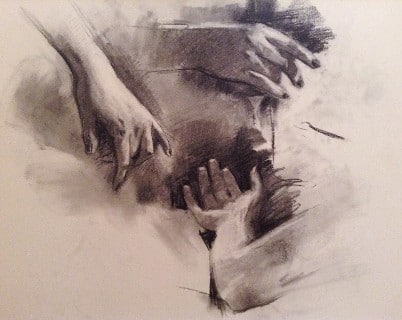
How to paint landscapes > Pennsylvania artist Patrick Lee creates loose, expressive figure drawings and abstract blot paintings in his search for pleasing designs. Those images may suggest a recognizable subject, or they may not.
How to Paint Landscapes: Use Your Imagination
As early as 1870, Thomas Moran (1837–1926) experimented with “blot drawings” he made by applying sepia or India ink to newspapers or other absorbent drawing papers, then folding the damp paper several times. After unfolding the papers, he studied the shapes, patterns, and textures to find suggestions of landscapes. He believed the universal patterns in nature could be found even in those seemingly random, accidental marks.
Today, Patrick Lee is intrigued by the same universal patterns he can find within 4 x 5-inch black-and-white acrylic blot paintings on paper, or within expressive paintings of posed figures. “I don’t wait for ideas to occur to me,” he explains. “Rather, I make abstract patterns and line drawings, allow them to sit for a while, spin them around so I can consider them from every angle, and see if something comes out of them. What comes out might be people, chairs, or a landscape. Once I decide which image to explore, I go back into the drawings with charcoal and adjust shapes and values until I get a pleasing design. During that process, I am less concerned with the identity of the subjects and more focused on a pleasing design of light and dark shapes.
How to paint landscapes – Start with ink blot drawings, such as these that Lee created, to suggest ideas for paintings:
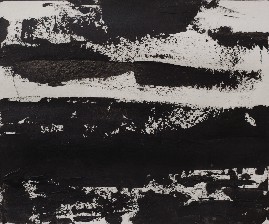
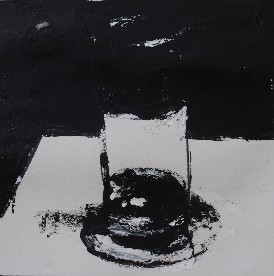
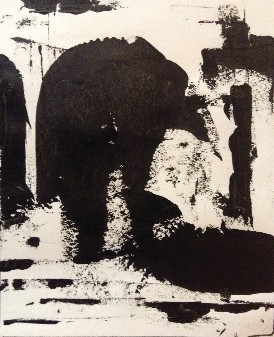
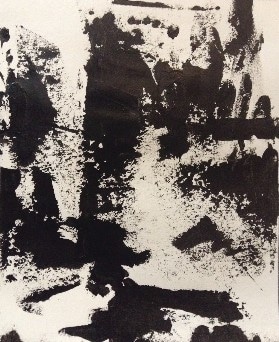
“Artists are not always conscious of the marks they make or the subtle influences on the mark-making process. Each of them has his or her own individual approach, and it may be shocking to learn that one’s individual marks are more true to one’s nature than the identifiable subjects described by those marks.”
Given his belief that mark-making is important to creating art, it is not surprising that Lee spends a lot of time looking closely at paintings by other artists and doing black-and-white drawings. When asked about some of his charcoal drawings in which he rubbed vine charcoal to make it lighter in value and softer at the edges, Lee mentions he learned a lot from looking at the drawings and paintings of John Singer Sargent.
“I looked at Sargent’s charcoal drawings on laid paper, and tried to emulate the beautiful balance he achieved with strong, dark lines and soft open areas,” Lee says. “I tried doing something similar with vine charcoal, Alphacolor soft pastels, and compressed charcoal to achieve that balance. After an initial application of one of those soft materials, I used a T-shirt or sock to rub it and get the same image as I would when I squinted to see the subject. The subsequent dark lines corresponded to what I see with sharper vision.”
How to Paint Landscapes Inspired by Sargent
Lee also adapted some of Sargent’s techniques for using oil colors. “He used a lot of paint on his canvases, and that allowed him to suggest things he didn’t actually paint in detail,” Lee says. “I always point that out to my students at Allegheny Community College when I urge them to be generous with oil colors and really good brushes. Good mark-making depends on having a brush that responds well to the motion and pressure of an artist’s hand and using it to move thick paint around the canvas. If they have limited resources, I suggest they buy cheaper paint and stick with quality brushes.”
[Related > Learn how to paint landscapeswith these popular art video workshops!]
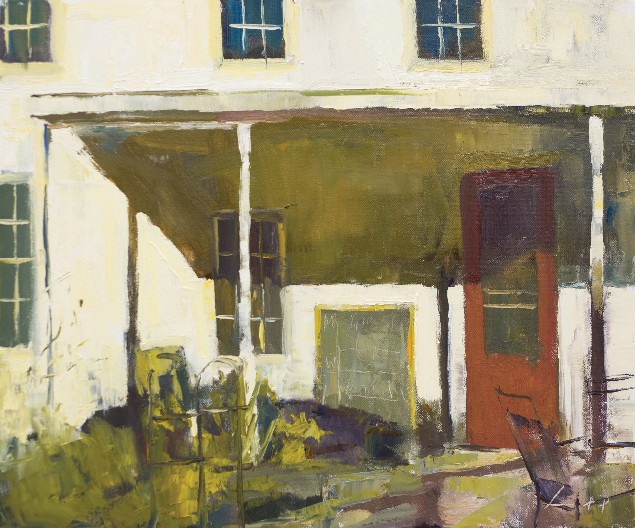
Lee has learned about other painting options from artists like Stuart Shils, a Philadelphia painter whose lusciously painted images verge on pure abstraction. “He creates amazing compositions in paintings, monotypes, and photographs,” says Lee. “He uses simple abstract, combined shapes, offering just enough information to explain the subject, often with big fields of color.”
This emphasis on abstraction changes somewhat when Lee participates in a plein air festival. “I have to offer more specific information about a subject when I know potential buyers want to understand exactly where I was painting in their town,” says the artist. “That’s not a big compromise because I love traditional plein air, and I can include identifying information with simple shapes. For example, I was painting Black Angus cattle on a farm made available during a plein air event, and I cropped my design so I focused on one specific aspect of that place. In the end, the farm could have been anywhere, but it appealed to a local collector who felt it had the right sense of space.”
Lee goes on, “In general, I begin my plein air painting process by walking around a place for a while, looking at things and using a viewfinder to isolate a simple composition. That viewfinder is one I made by cutting a hole in a piece of mat board so the opening dimensions have a 5:6 ratio. I cover the opening with red plastic, and I draw vertical and horizontal lines across the plastic. The red eliminates color so I only see value relationships, and it flattens the image into abstract shapes.
“After resolving the preliminary studies, I find one thing about the subject to focus on and start painting that, always asking myself, ‘Why paint this?’ and, ‘What do I really want to emphasize?’ I always paint on a white surface with a warm and cool of each primary, plus white. I never use earth colors. As I paint, I progress from painting colors with high chroma and knock them down.”
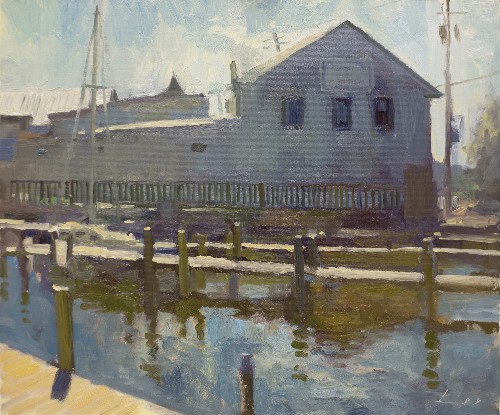
How to Paint Landscapes: No Filters
“There is no better way to learn than through plein air painting,” Lee asserts. “There are fewer filters between the artist and the environment, and the rapidly changing scene forces artists to deal with the basics of painting. There is an inevitable fidelity to what you are trying to paint — the time, location, light, etc. One has to deal with the raw data and paint from reality. Information in a small sketch helps build in an artist’s memory bank.
“In the studio, my creative process is slightly different. I use quick studies, plein air paintings, and photographs as reference, but mostly I rely on my memory as a point of departure. I may pick up a particular look in the plein air painting, a small gouache study that reveals a lot of details, or sketchbook notes as resources. As I work, I try to capture the feeling, mood, and overall concept.”
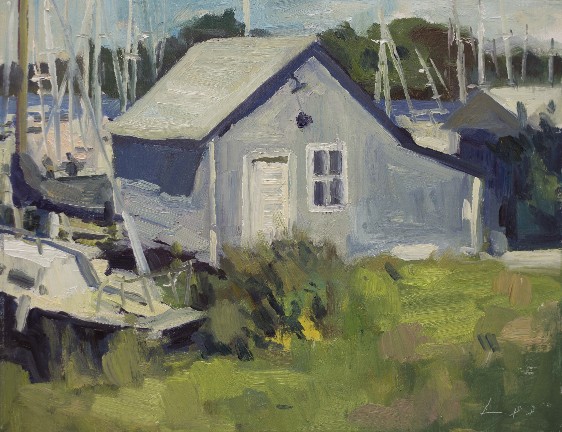
Lee has been adding Neo Megilp to his oil colors to scrub in the initial design of a painting. “Adding the Neo-Megilp allows me to apply relatively thick paint and have it dry fast enough that I can continue building up and adjusting the colors on the canvas,” he says. “I squeeze out big piles of paint on my palette when I get started and work wet-into-wet using bold strokes of color. That has the effect of suggesting things that are not painted in detail. It’s as if the paint has a life of its own that can lead to greater art because of the level of suggestion. This can allow for more powerful effects than I could achieve with a lot of individual details.”
Lee adds, “This way of painting conforms to the way we actually see things. We don’t focus on everything in front of our eyes. Rather, one shape will be in sharp focus while things surrounding that shape that fall within our peripheral vision don’t have the same degree of definition. That’s one of the reasons photographs are less valuable to a painter than sketches, drawings, or memories.”
Lee believes firmly that doing plein air painting on a regular basis is one of the easiest ways to learn to paint. “Outdoor painting may be more difficult in the beginning, but it becomes easier as time goes on, and it will prove to be a good way of learning,” says the artist. “It presents challenges in establishing fidelity between what one sees and feels — in terms of the light, time of day, season of the year. That experience of painting from reality will inform sketches and oil studies, and that in turn helps build one’s skill set and memory bank.”
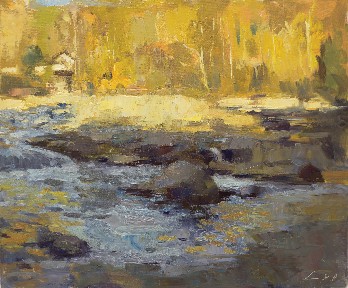

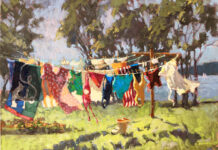
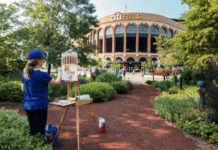

Great article! Wonderful to read about an alternative method not typically employed by most plein air artists. Thanks for sharing your thoughts Patrick, you are truly one of the groundbreaking plein air painters of our time.
[…] https://www.outdoorpainter.com/unleash-your-imagination-abstract-art-how-to-paint-landscapes/ […]